The Plan
To make an automatic wrist watch case and dial.
May 15TH Proposal
A brief, and unfortunately limited, proposal outlining what I hope to do in Level 6.
Idea MIND MAPPING
I didn't know where to start so I decided to create a mind map because it may provide some guidance.
Watches 101
Value
Every Analog watch contains a movement, Automatic, Manual or Quartz. Movements are the most complicated and important part of a watch. As a result many manufacturer's buy in the movement from external companies. The most common and recognisable company is ETA, who is owned by The Swatch Group Ltd. In contrast, the term "manufacture movement' or 'in-house movement' is defined as "designed and produced entirely in-house by the company that makes the watch". Watchmakers who decide to use movements from ETA often "refine, customize, and rename them for branding purposes: Breitling’s Caliber 13 and IWC’s Caliber 79350 are among many chronograph calibers based on the popular ETA 7750". The Swatch Group Ltd don't just manufacture movements, they own some very popular watch brands such as, Breguet, Hamilton, Longines, Omega, Swatch, Tissot to name but a few. These brands technically use "in-house movements" because they are related to ETA. This means that the exact same movement that is used in a Swatch could also be in a IWC. The same internals but set at very different price points. The logical thought process from here would be that the Brand and physical form creates value, but it doesn't. None of the brands that use external movements or related movements have any sort of real value in the watch market, unless they bring something truly unique to the table. Rolex, Audemars Piguet and Vacheron Constantin are the only three Brands that have any real value in the market, mainly due to their pure in-house movement manufacturing.
References:
Example of False value
Many people believe, if you pay a lot it's worth a lot. That's far from the truth, essentially with Hublot.
For example the "Hulot Classic Fusion Chronograph Black Magic 42MM" (picture on the right) is available for purchase today (10/09/2024) for £10,600. Hublot states this watch has "HUB1153 Self-winding Chronograph Movement" which is 'technically' in-house but still classed as a "derivative movement", based off the "ETA caliber 2892-A2". That same ETA movement can be found in the "Hamilton - H38525721 Jazzmaster Thinline Auto 40 Stainless Steel / Beige" that is priced at £915.00 again available for purchase today (10/09/2024).
A nearly identical movement selling for a little over 10x the price is ridiculous. Expectedly the Hublot's Market Price is £4587 as of (09/09/2024). VALUE COMES FROM THE MOVEMENT!
References:

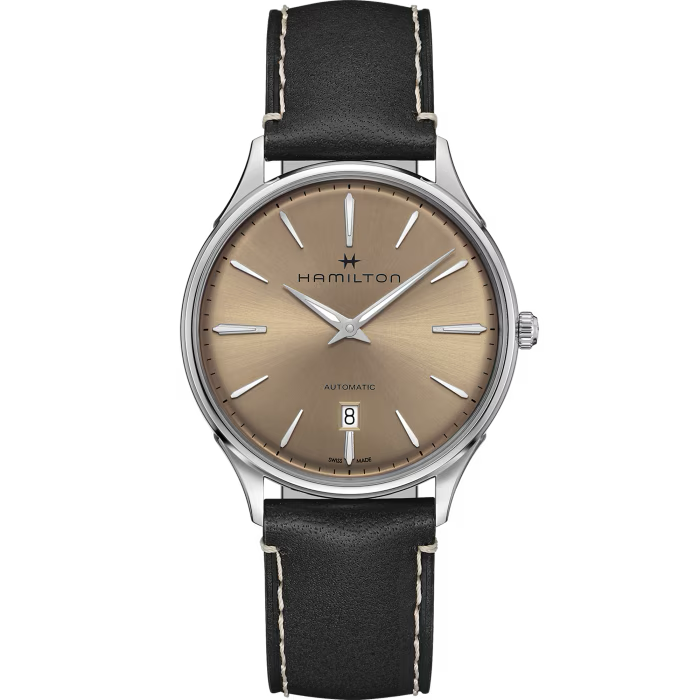
My Watch and its value
I previously clarified that the movement is the value. I did this to help people understand that designing a watch doesn't necessarily mean designing a movement and in this project I am designing a watch. I have chosen the Seiko Caliber 6309A movement because it is the cheapest one I could buy, it is simply a placeholder that I can work around. Once completed I could change my internals to fit a different movement, if I so desired.
Tear Down and Disassembly of Seiko 5
In order to gain an understanding of what I need to design, I bought a fully working Seiko 5 from chrono24 for £77.00. The movement is Seiko Caliber 6309A. My idea is to disassemble the watch and learn how it goes together and the dimensions required to start. If I don't break or damage the movement I will then use the movement in my final design to create a fully working watch.

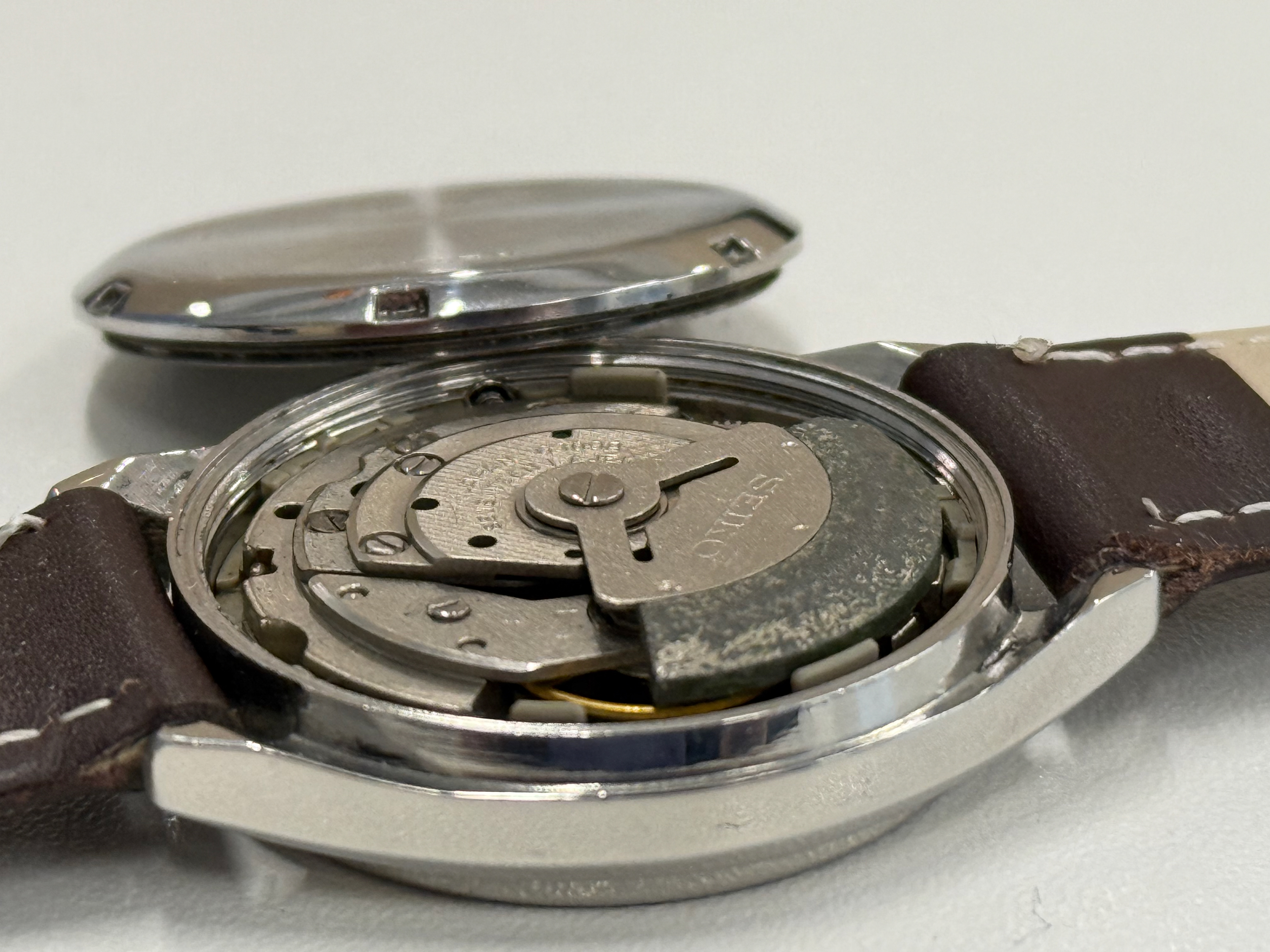
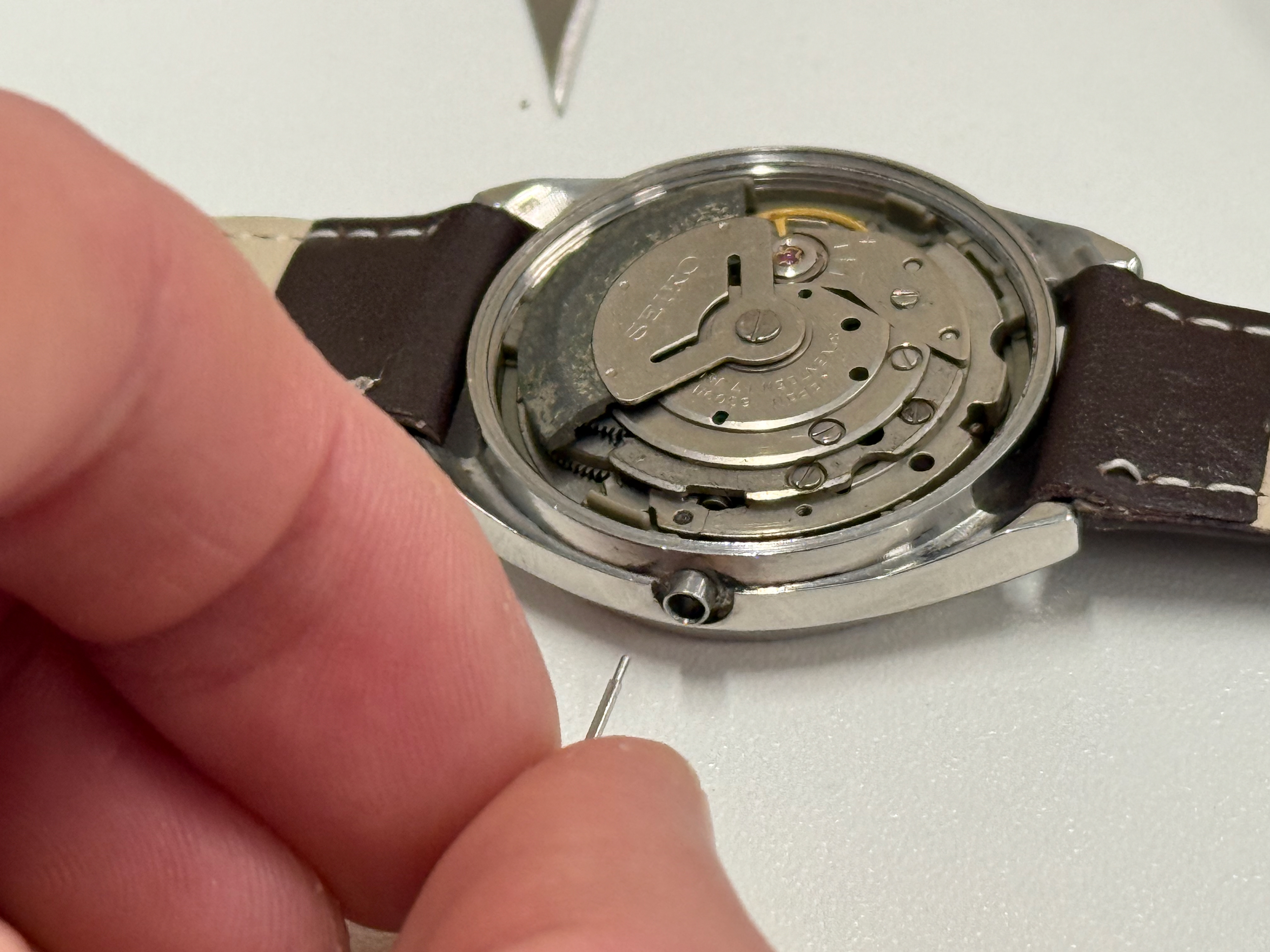
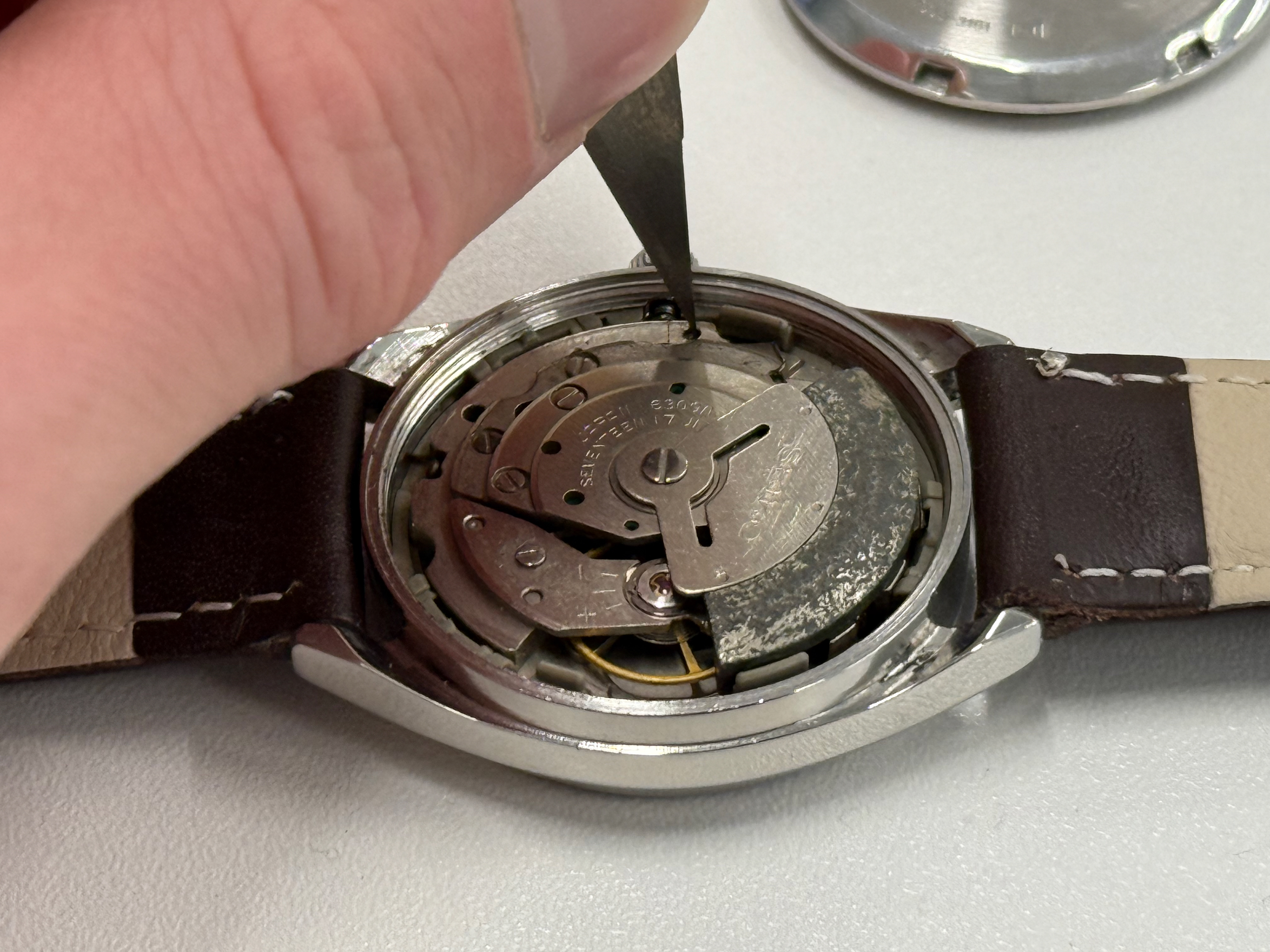
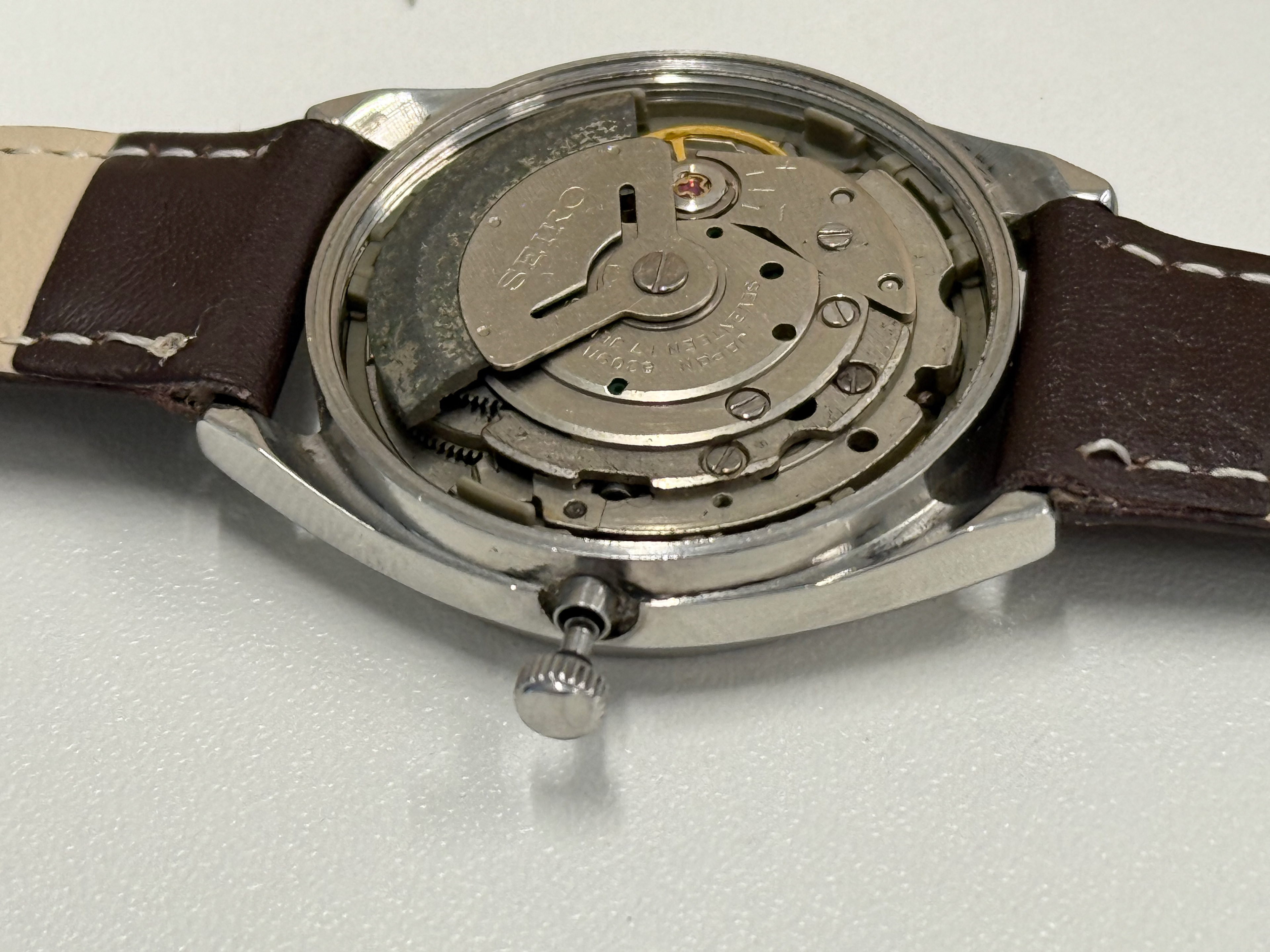

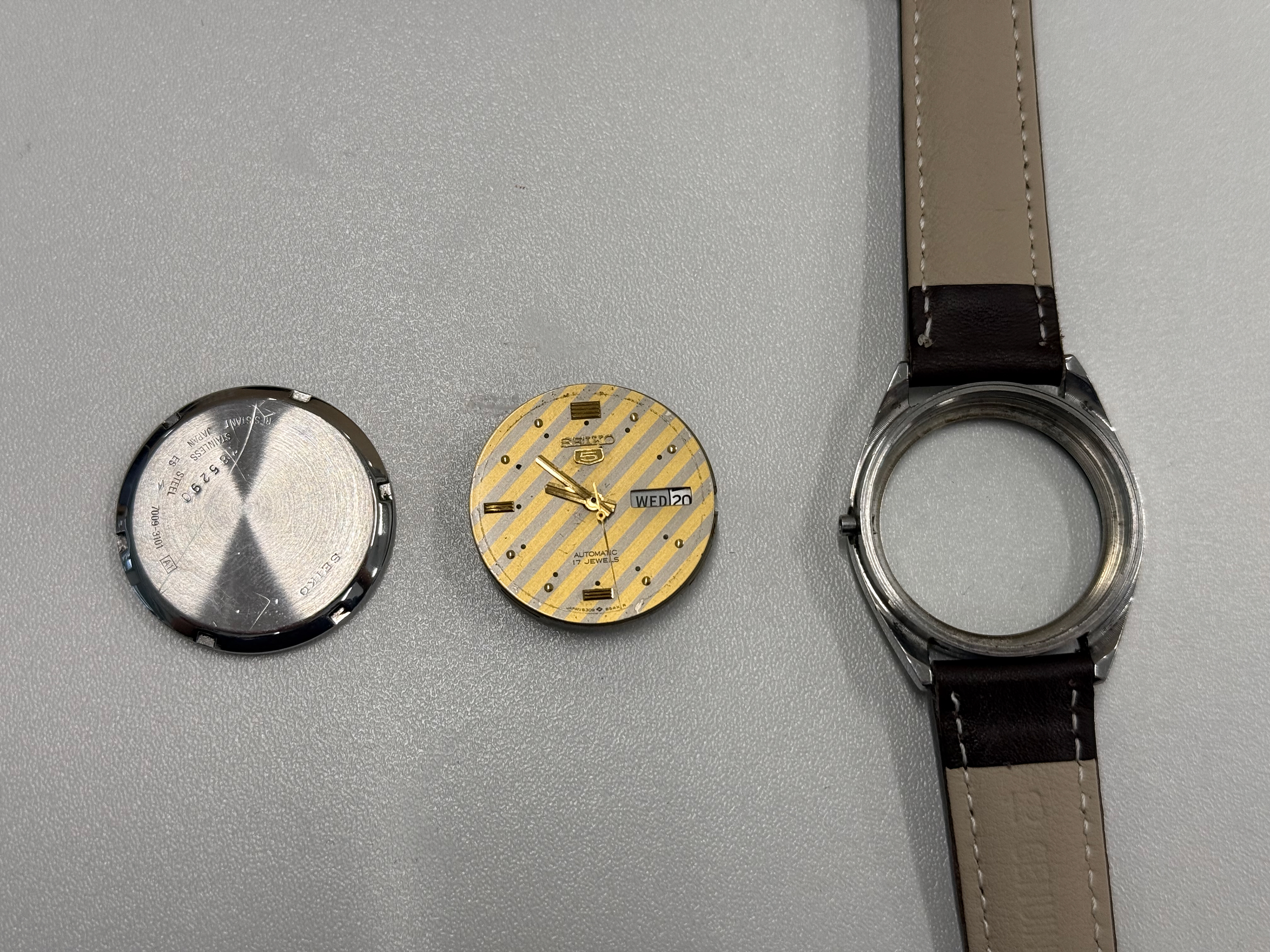
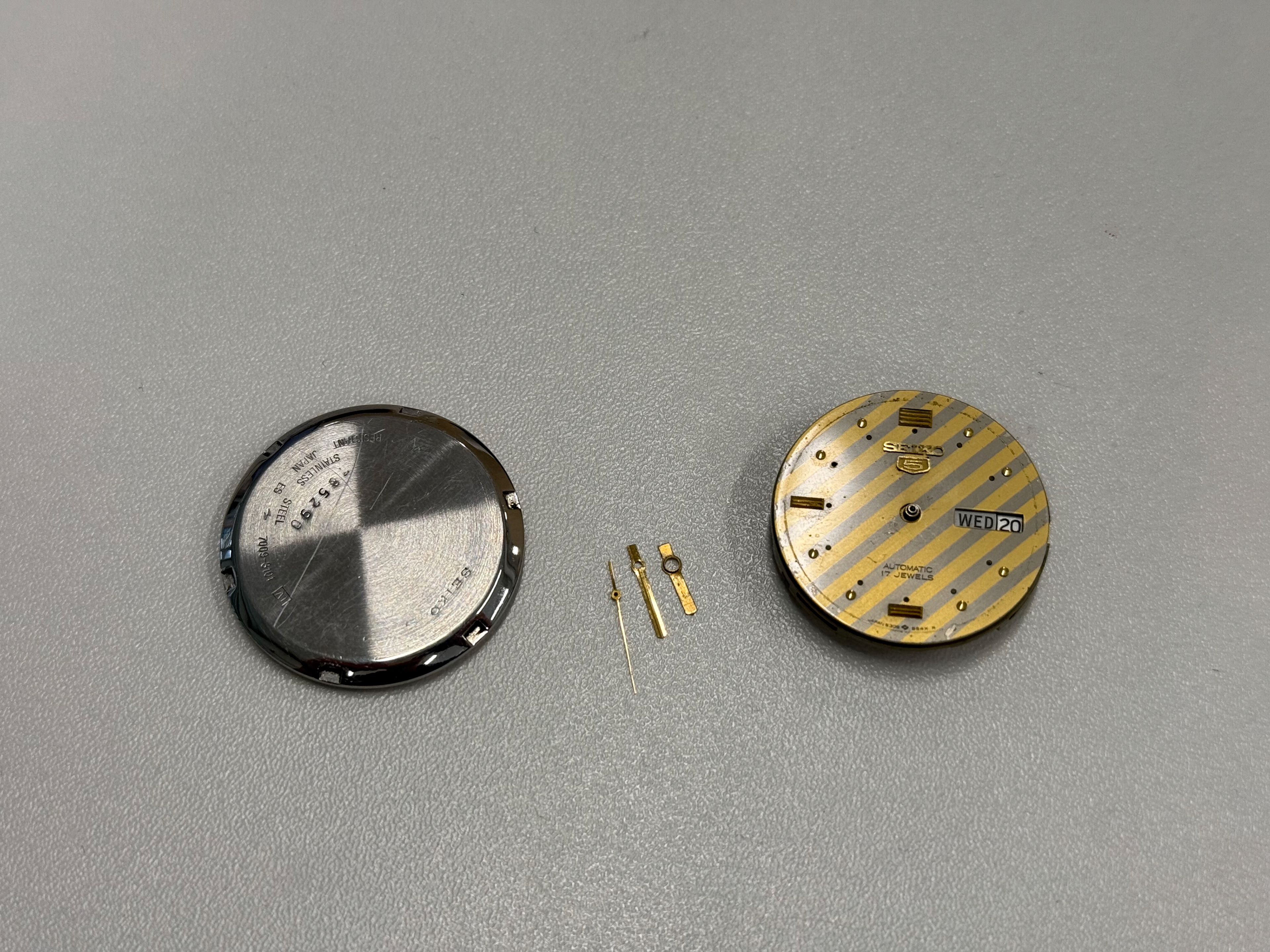
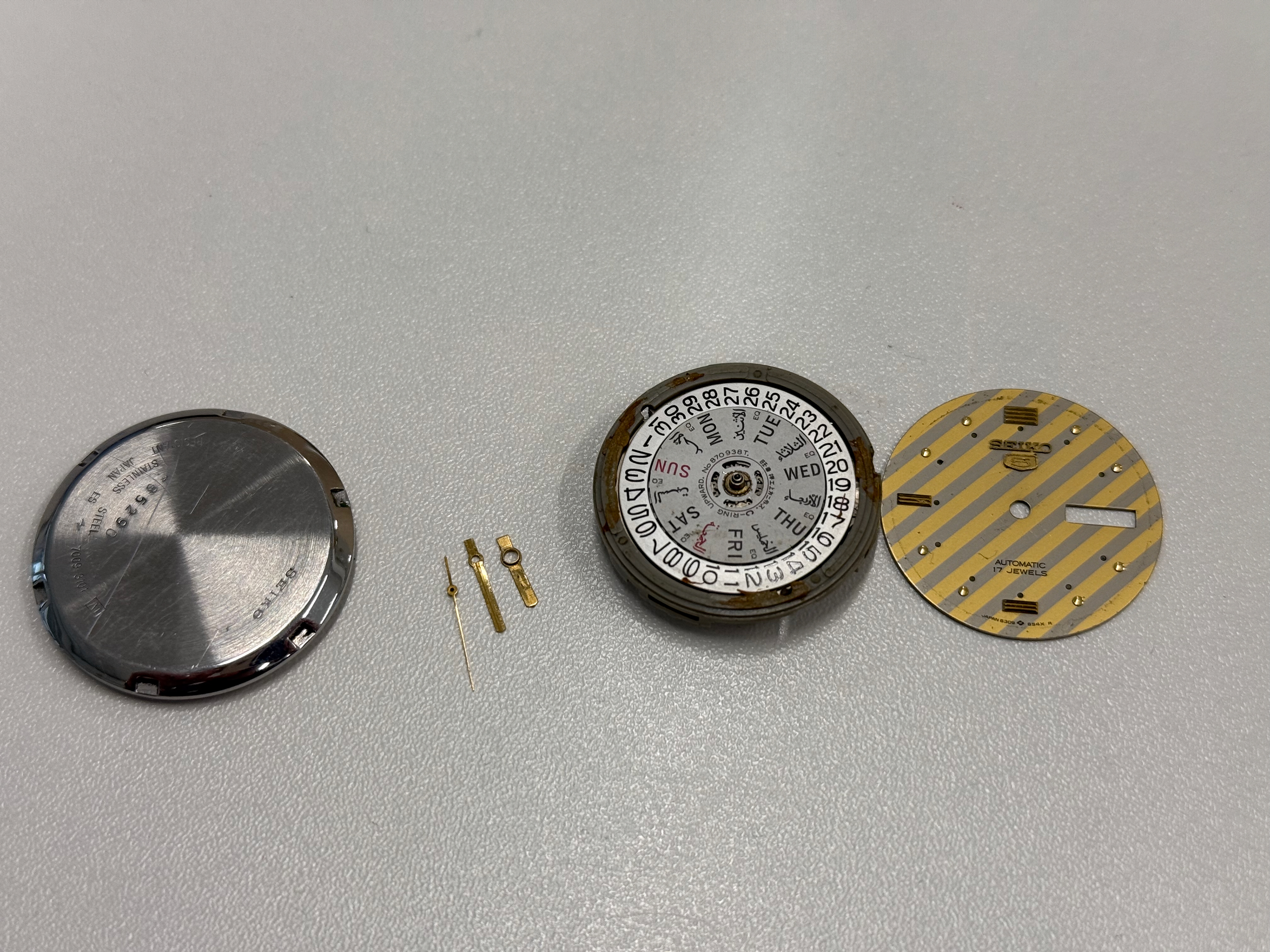
Outcome
The result of this tear down has shown me how easy it is to dismantle and rebuild the movement. The next step will be to create a foundation for the movement to sit in perfectly. It must sit exactly like it does in its current case to ensure everything fits and works as Seiko intended. To do this I must take measurements of the watch but since I lack the equipment here, I will have to use the manufacturers measurements.
Dimensions
We can see the diameter is 27mm and the height is 5.3mm. I will now create this in Fusion360. However, I will add a small amount to both measurements. 28mm and 6mm will be the initial test, it will also make it much easier for me to measure shrinkage with them being whole numbers.
Assembly
During the rebuilding process of the watch, I had the realisation that the assembly of a ceramic watch is going to be the hardest part to figure out. I quickly came up with a few off the bat ideas. These obviously need much more refinement but they are a start.
The first is simply just using adhesive to attach the glass to the case, I got this idea from Apple Watch. The second is having the glass in its own case and then the two cases screw together. The third is a thread in the case and the bottom unscrews out. Non of these ideas are ideal but my favorite is the second one, being inspired by the Richard Millie design.

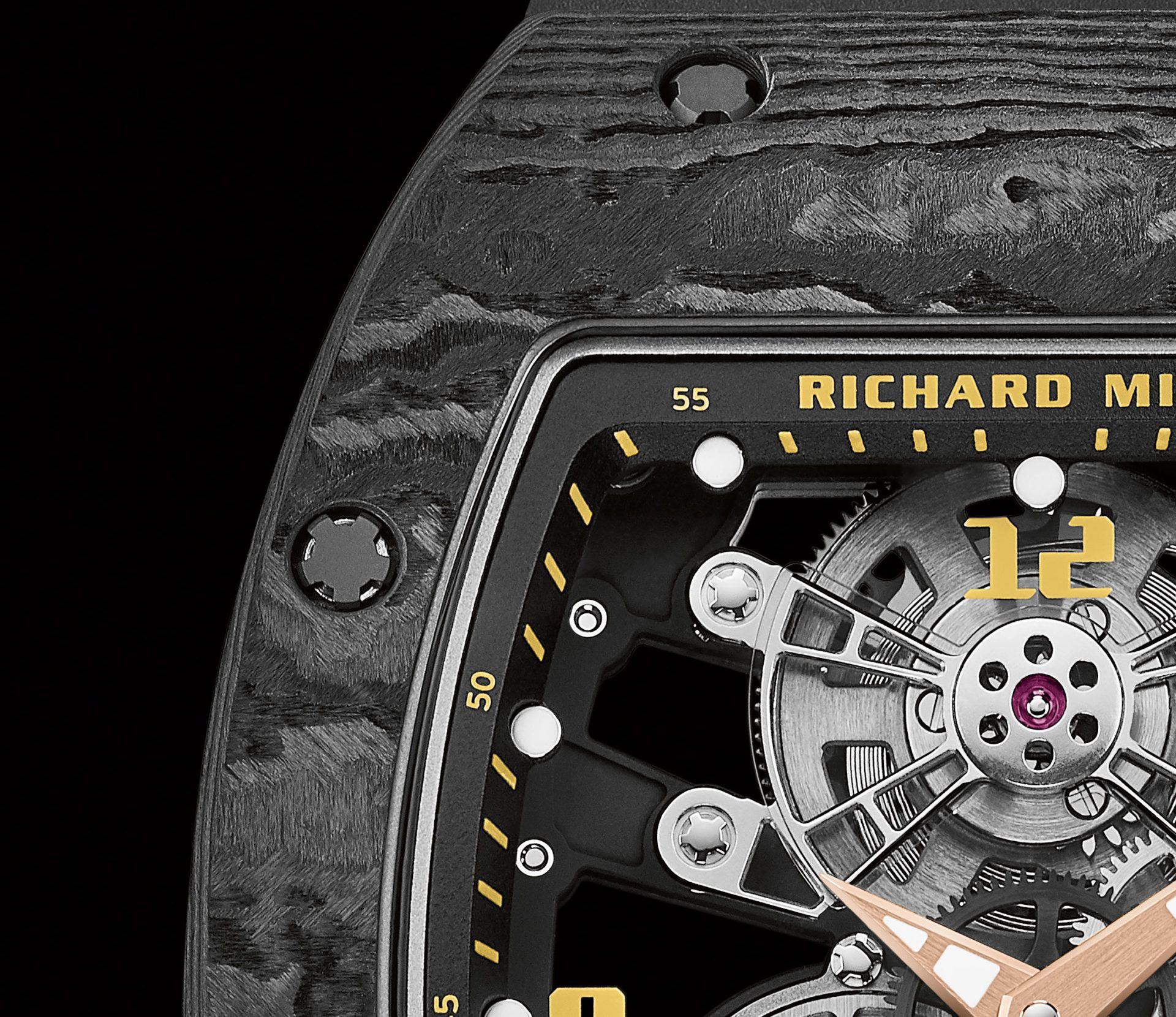
Material
Upon return to university, it became very apparent that using the WASP 2040 wasn't going to be viable. I was instead directed to Print City to talk about Alumina. Ahead of talking to Print City, I did a bit of research into what specific material Apple Watch used as a possible other option. Although Apple used Alumina, I also found that "Watchmakers use a ceramic material with very fine pores. It's called zirconia...". Both Zirconia and Alumina are both within the technical ceramics branch, which immediately causes concern for me. Another cause for concern is that 2KG of Alumina 3D Print Resin is £1249.80. This is concerning because with an average 42mm watch weighing around 150G, the cost to make a single object is at a minimum £94, which is fine for a couple of prototypes, but I may need to make 10+ prototypes to get a final design. That cost is purely for the resin and not any other costs. But Print City may be able to help explore the real cost. Technical ceramics means that this is deviating from what other people on this course are doing and getting into the world of engineering, which creates a lot more work for myself to jump through the learning outcomes of this course.
https://formlabs.com/uk/store/materials/ceramic-alumina-4n-resin/
Feedback Responses
Proposal (Written 20th June 2024)
Why watches?
Firstly, I love watches. I took apart and, to my grandparents’ dismay, destroyed my first pocket watch at age 5 trying to understand how it worked. Probably as a result of that, watches are something I've always loved and fantasized about owning. It’s a product that is unlikely to die, automatic movement watches especially. Digital watches at some point slow down and die; it’s not possible for them to last decades or centuries. This is also the industry I want to go into as a career. Some people wear rings and jewelry to express themselves; I wear watches. Currently, I have two, a Tag Heuer Carrera Calibre 5 and a Mr. Jones Watches Beam Me Up!. The Tag Heuer is the watch I wear for special and nice occasions, whereas the Mr. Jones Watches is a very fun and playful one that I wear for most other circumstances. I want to make a watch that is as much a conversation piece as the Mr. Jones Watch is but also as "smart" and "classy" as the Tag Heuer, essentially bridging the two aspects I like from both my watches.
Why 3D Printed Clay?
Ceramic 3D Printing is unique compared to other ceramic processes. It is very precise (if configured correctly) and, as a result, is very good for small-scale objects. It also stands out and catches eyes (for better or worse).
Commercial production – is this the market you wish to enter?
I want to capture the attention of the companies and designers to start my career with them rather than working independently. This was reinforced by a recruiter who gave me information on the whole process and even told me about the Matas Brothers. The recruiter has worked with my father, and I’ve met him personally many times; he knows the correct approach.
Are you planning to use the WASP clay printer? Is this the right kit? Does the scale of printing lend itself to watches? If not, what printer?
I did want to use the WASP printer, but I'm not confident that the clay material accepted will be good enough. So once I return, I will have a conversation with Rudy on the best approach.
Presentation
I did not get the response I was hoping for from the tutors. This is worrying. It is possible that I misunderstood what this presentation was supposed to contain, and as a result, I didn't provide the information they wanted at this stage. If I am going to commit down this path, I need to collate as much information about this as possible and as quickly as possible. If I can get "approval" from the tutors and receive useful advice to keep me on track, I will jump straight in. Regardless, I do want to explore the theme of time. It may just be that my watch dial and case design is incorporated into a different form rather than a physical watch case.
Print City
Print city was a short and grounding visit. They essentially reiterated what the tutors said: my initial idea wouldn't be possible. However, they did explain the reason: cost. They don't hold the £1249.80 Alumina 3D Resin, and I would have to seek approval from the department to purchase it, which would certainly be denied due to it being for a single student and a single project. However, they said if I got it myself, I could use the machine and therefore proceed with the idea. Financially, this would be irresponsible, so unfortunately it seems that this idea was too ambitious. However, in my personal time I will pursue this and continue to find a way to make my watch. The use of Zirconia is possible and much more financially sensible. However, in the time frame I have, it’s not possible to conduct the required research. So I will now have to pivot my project... back to the drawing board.
The Pivot Plan
I’m eager to explore the concept of time further. When considering my next steps, the movie Interstellar came to mind, particularly the tesseract, a concept that portrays time as a physical dimension. Another idea was time dilation, which is again a form of time manipulation. The collation of these two ideas brings me to the manipulation of time so I will further explore this.
Initial Artist Inspiration
Salvador Dalí
Salvador Dalí was a surrealist who's renowned for his intricate detail, technical skills, and unique approaches. One of his most renowned works is The Persistence of Memory. It was a piece that came to him whilst hallucinating after eating Camembert cheese. The clocks and watches droop over the edges of the objects they rest on, exactly how Camembert would. The effect of the gravitational pull can be seen through distortion of the dials and faces.
He created notable variations of The Persistence of Memory (1931) with The Disintegration of the Persistence of Memory (1954) through painting. Through lithographs and sculptures, he created Persistence of Memory (1980), Nobility of Time (1977-84), and Profile of Time (1977-84).
Dalí unites these works through the exploration of time. His fascination and, somewhat, obsession with time is evident in all of these pieces. He conveys the passage of time as unreliable, fluid, and powerful.
Dalí's work gives me inspiration to think about how I interpret time. I hope that this will provide me with a path forward.

https://www.wikiart.org/en/salvador-dali/the-persistence-of-memory-1931
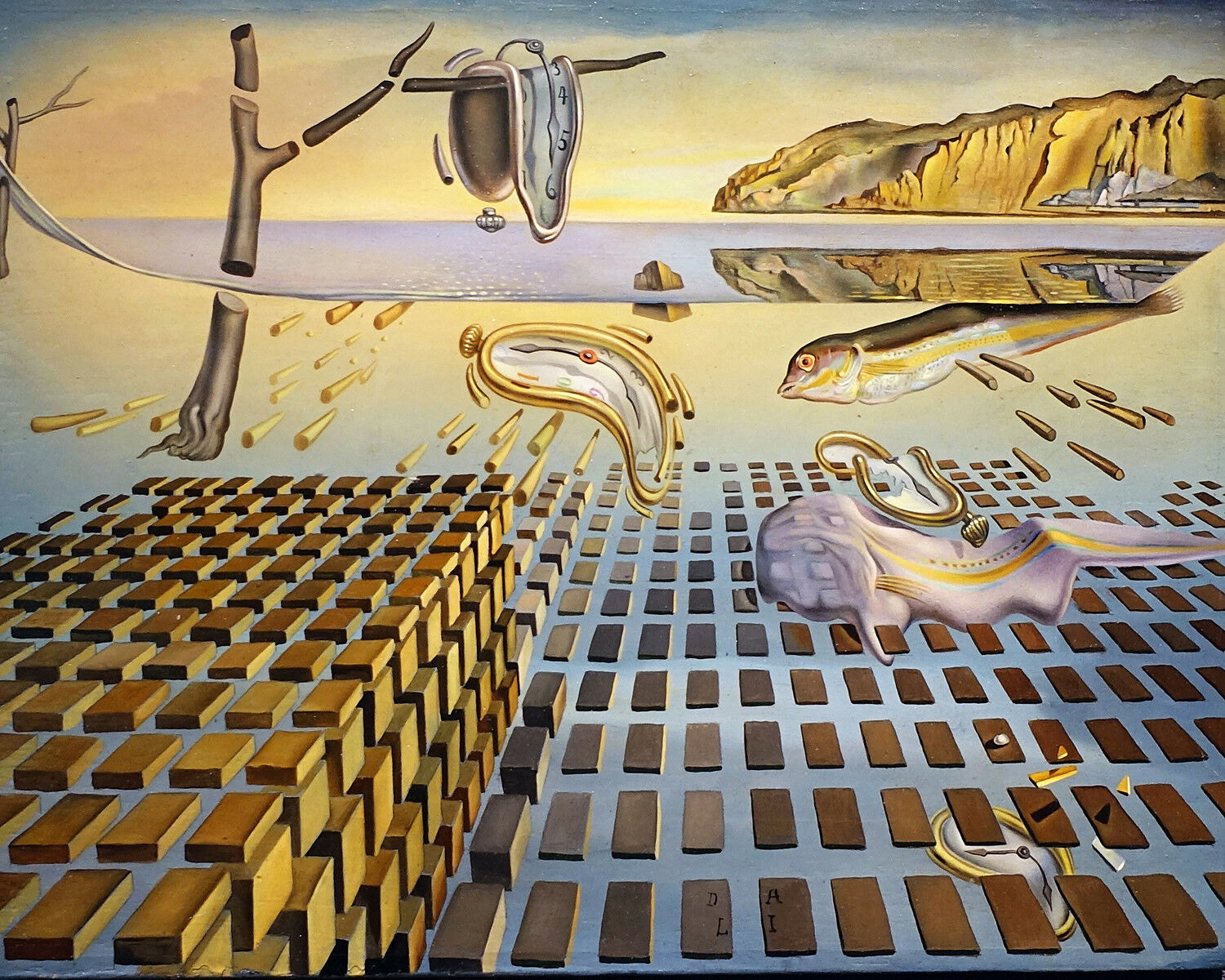
https://www.wikiart.org/en/salvador-dali/the-disintegration-of-the-persistence-of-memory
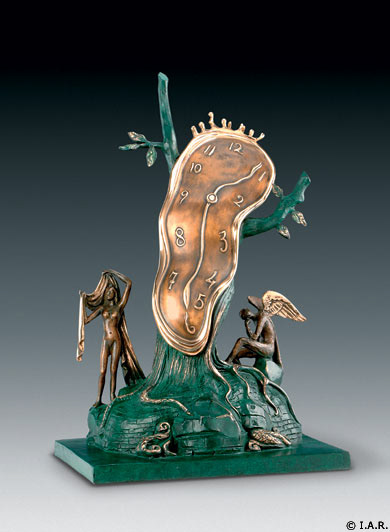
https://www.daliparis.com/en/gallery-item/nobility-of-time/

https://www.daliparis.com/en/gallery-item/persistance-of-memory/
Henri Bergson
Although Bergson was not a conventional artist, he was an incredible philosopher, and his work continues to have an impact on us today. His most important contribution for me, and arguably the world, is his concept of Duration.
Bergson’s Duration presents an alternative perspective to the conventional interpretation of time as a linear progression. He argues that time is a continuous, subjective experience. While science maintains a linear structure, with a minute being 60 seconds and an hour 60 minutes, time itself carries a subjective quality. As an example, when we were 10 years old, the passage of time to our next birthday felt significantly longer compared to now. This is because we had to wait a larger proportion of our life to experience it again. Conversely, as we age, the time interval between birthdays becomes shorter, as we only have to wait a smaller fraction of our life. i.e 1/10th of our life at age 10 and at age 50 it is only 1/50th.
Philosophy is an incredibly complicated subject to comprehend, let alone understand. However, the key aspects I managed to derive were: Intuition - a personal feeling, Qualitative - measured by ourselves, Non-Linear - time isn't a straight line, and finally Subjective - it's down to us as a person to interpret.
Going forward, I want to keep this idea with me when coming up with ideas and how I can communicate this theory into a real-world piece. The key link between Dalí and Bergson is the word “fluid." Both artists believe that time is constantly moving and is adaptable yet is a huge power structure.
Sketchbook
Initial Idea's
After my research into Dalí I noted down my initial ideas for where this project could go.
I then did the same with Henri Bergson.
Inital Sketches
Two very brief ideas that immediately came to mind once I conducted the mind maps above. I am terrible at drawing, so I used Grok 2 Mini to generate the image for the Clay Ball and Plaster to help demonstrate the idea.
This image, made with Grok 2 Mini, specifically captures when it would be freshly made. It wouldn't have had any exposure to the outside at this point.
I would generate an image to better represent the other sketch, but I can't describe it in the required amount of detail.
Further Bergson Research
Upon further research into Bergson's ideas, the two words homogeneous and heterogeneous became a major point. The definition of homogeneous is uniform or identical. Whereas heterogeneous is the complete opposite, nonuniform or unique. Bergson argues that duration is heterogeneous. These are the two definitions I want to work with and explore how entities experience duration and how I can impact an object’s duration.
Thomas Heatherwick Talk
I was fortunate enough to attend a Q&A talk at the University with Thomas Heatherwick as the guest speaker. He told us his story at this university and what he created for his final year piece. Telling us how he enjoyed and got far more out of this establishment than when he attended the Royal College of Art.
The key takeaways from the talk for me were:
1. Find Your Niche: Look for what other people aren’t doing. "Find something that there aren’t many experts at and become an expert at it."
2. Think Creatively and Resourcefully: Embrace the challenge of creating innovative solutions, even with limited resources. Understanding and enhancing public experience is crucial for creating impactful designs.
3. Be Collaborative and Open: Success often requires teamwork. Understanding and working well with others are crucial in achieving great things together. Learn to appreciate diverse perspectives and skills. "You go so much further and faster in a group where you can’t even say who designed it or didn’t, it doesn’t matter."
4. Challenge Norms and Think Outside the Box: Continually question what is accepted and seek to do things differently or better. Challenge initial assumptions and try to find innovative, meaningful alternatives. "If you do something that is out of people’s normal mode, what they expect should happen, it’s worth doing."
5. Embrace Failure and Learn from It: Understand that mistakes are part of the process. Learn from them and let them guide your future endeavours.
6. Consider Public Impact and Service: Remember the importance of social responsibility in design. Recognise that buildings are a public service, so consider both client desires and public impact to create beneficial projects. "You have two clients because the other client is the public."
7. Focus on Emotion and Experience: Balance form and function with the emotional impact of your work. Design should prioritise the experience and emotions it invokes in others. "Emotion is a function."
8. Remain Humble and Approachable: Stay grounded and open to learning from everyone, regardless of experience level. New ideas can come from anywhere and anyone.
9. Value Personal Growth and Development: Use your work experiences as stepping stones to future achievements. Continuously seek learning and improve from each project.
10. Communicate Effectively: Avoid jargon and strive to explain your vision in terms that are understandable to people outside of your industry.
Mark Tutorial Feedback (10/10/24)
The last time Mark spoke to me was during my presentation. Obviously, since then, I have pivoted my project and taken a new approach, so I ran him up to speed. I showed him the three versions of the slip vs plaster I have made and asked for his input. His feedback was to make more versions, find the key aspects I like within each, then make a final one that incorporates them all. I like the idea of making more and have the last one be my favourite, but the incorporation of different aspects from others I don't think will work, purely because the plaster is heterogeneous and I can't (really) have too much of an input. That is if I want to stick with Bergson's definitions.
Great Northern Contemporary Craft Fair
I was invited to show my work alongside other Manchester School of Art Craft students. I proposed two pieces; this was the one that got chosen. I then wrote a small statement that would be printed in the zine, showcasing all our work. At the fair, I spoke to members of the public, explained what we were showing, and the process that we were currently undergoing. Not only did it allow me to show my piece to the public, but it gave me an understanding of the work and effort that goes into curation, not only at the show but the weeks leading up to it. I was unfortunately not part of the core committee, but I offered my help.
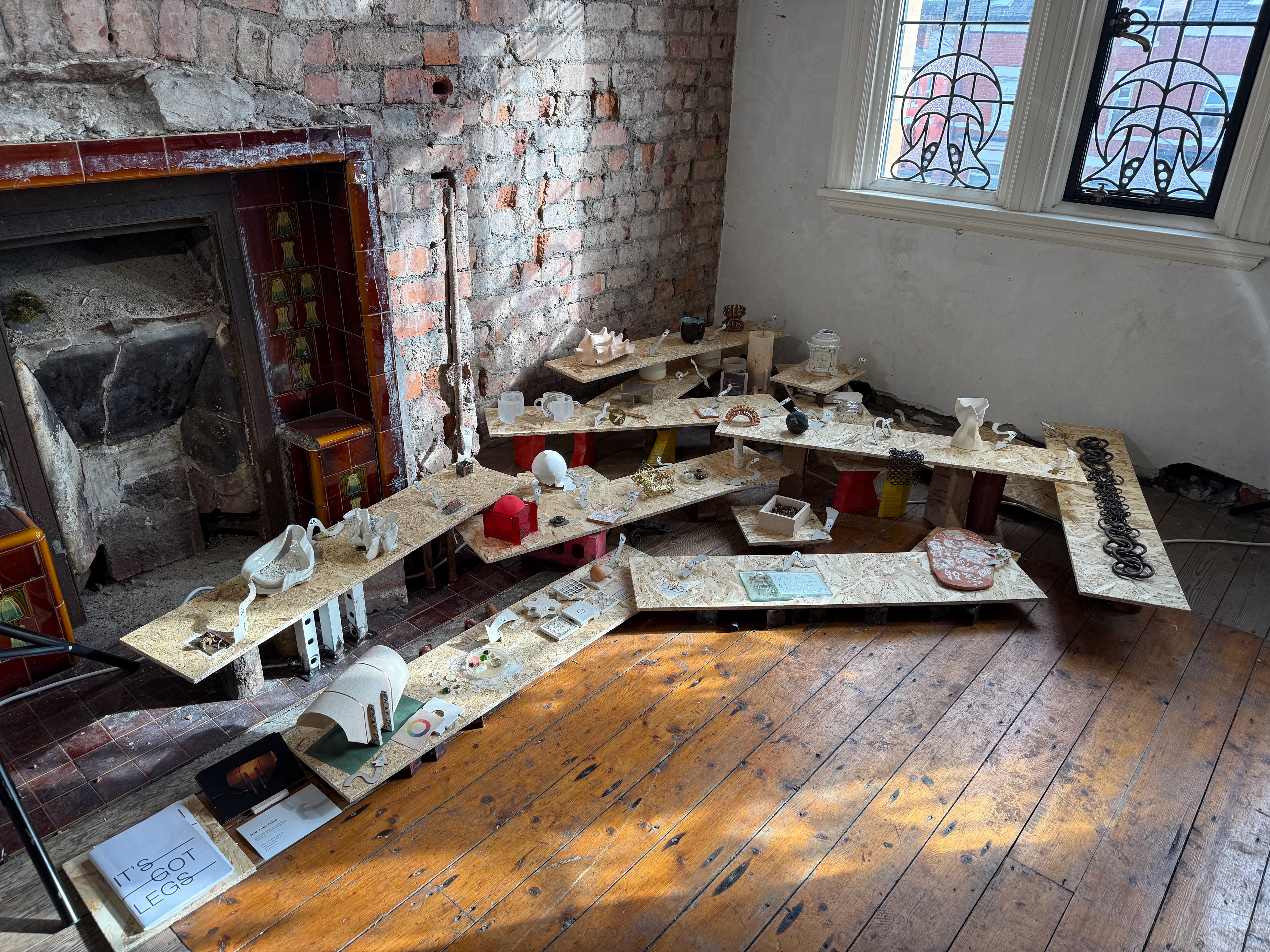
Its Got Legs - The curation of our work
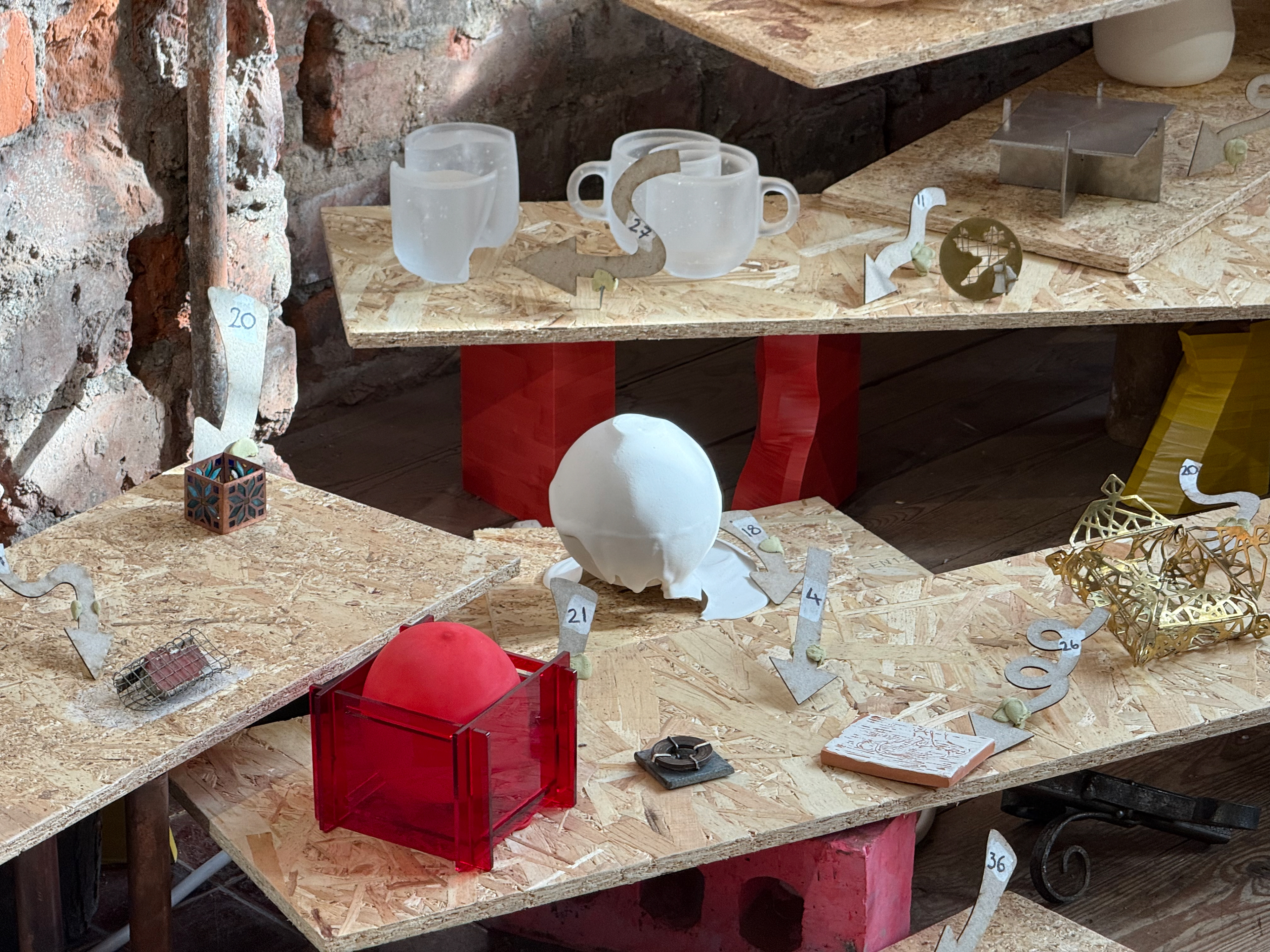
My piece
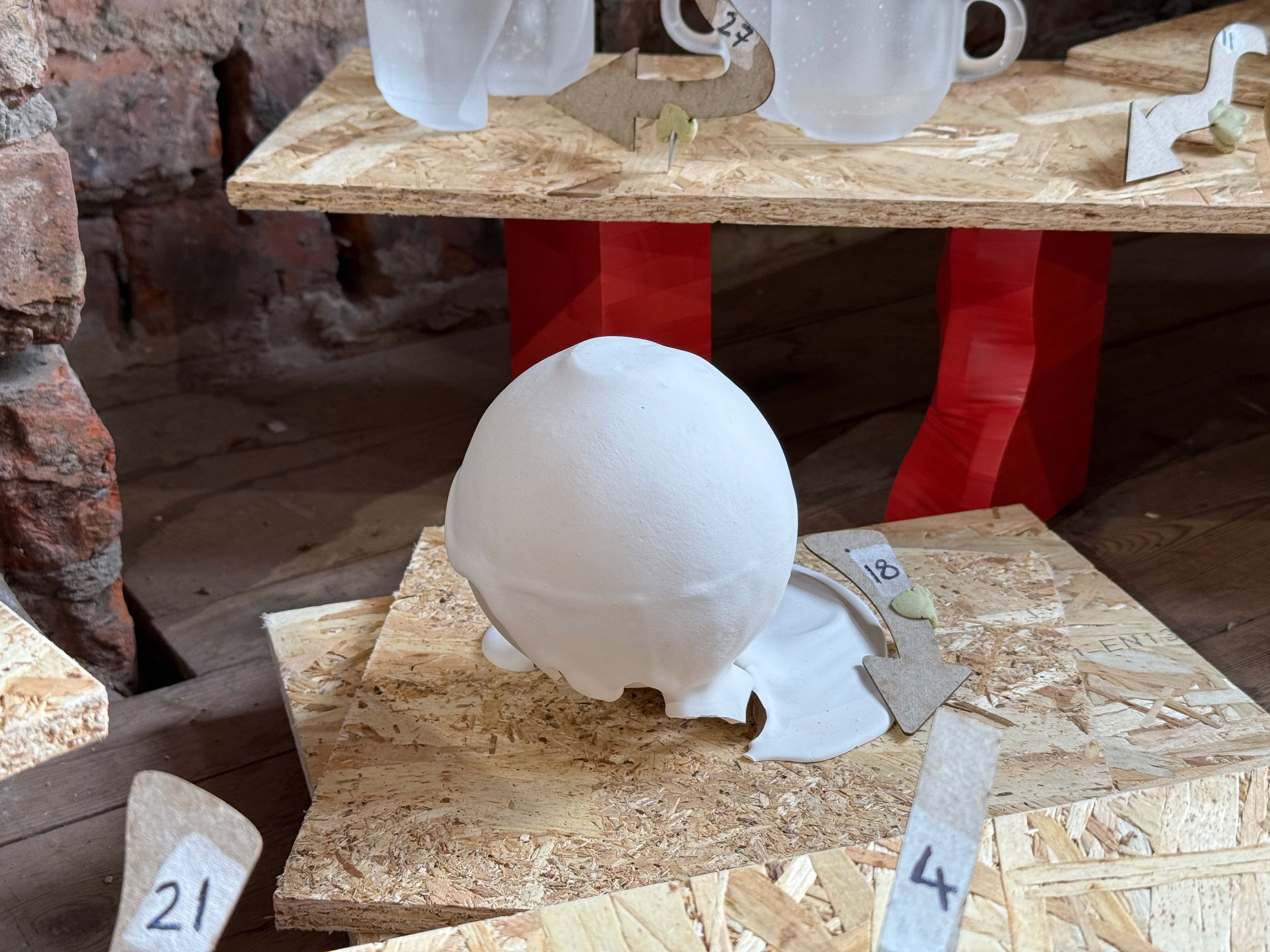
Close Up
REFLECTION AFTER READING FURTHER PHILOSOPHY FROM BERGSON
Over the past four weeks, I’ve crafted five distinct Slip and Plaster pieces. Each piece was designed to uncover a unique purpose, and as a result, they’re all heterogeneous objects.
However, upon reading more of Bergson's work, I felt that the slip ball aligned more with the definition of homogeneous rather than heterogenous. So what does this change? Nothing. It actually reinforces Bergson's idea of Élan Vital; the slip ball serves as this canvas upon which the plaster flows, showing the dual perspectives of duration.
Mark Tutorial Feedback (24/10/2024)
I went to Mark to explain what I've done so far and where I am currently stuck. I explained to him that I have looked at both the Homogeneous and the Heterogeneous. An aspect I thought had potential but didn't know how to progress was the cracked pieces of plaster. They have the smooth inside from the homogeneous slip ball but the heterogenous aspect of variation on the outside. Mark, however, took a unique viewing point and pointed out that the residue from the plaster on the slip ball was a potential route to explore. We've got the Homo and the Hetero, what about the bi? This really stuck with me because not only is the residue the 'bi' but the cracked plaster pieces are themselves the bi.
Thinking back to the Thomas Heatherwick talk, he said "hunt for the gap" which the gap between Homo and Hetero is the 'bi'. So by looking at the 'bi', I have hunted for the gap and now I am exploring that area.
Formative Review 1 Feedback (28/10/2024)
KEY POINTS FROM THE CONVERSATION
1. Clarification of focus - hard to identify the critical aspect of the project.
2. Concept of Residue - consider the 'bi' aspect and how to follow that path.
3. Struggling to find a reason to use LiDAR due to transforming it into physical resolution.
4. Project Direction - Struggling to find the connection between current work and the next step.
5. Essay - didn’t provide a clear path but led to the emergence of two key definitions.
6. Material Selection - Why focus on Slip and Plaster? Look at WaIx, Jesmonite?
7. Reflection - needs more reflection everywhere.
GRADE AND FEEDBACK (15/11/2024)
After proportional weighting including removal of LO1: Grade - 50.55 (Good/Pass)
Marks: LO1 - Unknown, LO2 - 42, LO3 - 52, LO4 - 62
Areas for Improvement
Portfolio Consistency - Improve the organisation and clarity in labelling sections like sketchbook and research and development. Be consistent in categorising content to avoid confusion.
Proactivity - Increase proactive engagement. Rather than waiting for responses to emails, consider arranging meetings or directly contacting relevant individuals to move the project forward.
Communication and Tone - Be mindful of language and tone in communications, especially in reflecting project stages. Ensure that communications are positive and assertive without attributing blame unnecessarily.
Technical Skills and Tools - Consider using alternative software tools like Mesh Mixer for better control and results in object creation.
Methodology Understanding - Clarify the project workflow, from primitive object usage to materialisation. Solidify your understanding and application of project methodologies.
Vision and Goal Articulation - Develop a clearer articulation of what you aim to achieve with the project. Investigate potential end products and materials, such as glass or metal casting, that align with your project goals.
Networking and Collaboration - Expand your network by collaborating with other disciplines and pursuing additional avenues related to your work beyond initial concepts like watch design.
Narrative Alignment - Ensure the narrative aligns with your project’s methodology and material choices, especially when discussing intangible elements like the echo of impact.
Strengths
Idea Development - Successfully developing and researching ideas, particularly around your exploration of a standard primitive like the sphere and its interactions.
Progressiveness and Adaptability - Demonstrates adaptability in various stages of project development and ideation, thanks to reflective practice and learning from past projects.
Communication Skills - Effectively utilising different platforms to demonstrate and evidence work, enhancing communication proficiency in showcasing projects.
Tangential Exploration - Engaging with philosophical or conceptual underpinnings of the project, moving beyond mere materials to explore deeper meanings and implications.
Overall, while the project shows great promise, there’s a need for refinement in organisation, clearer goals, and proactive engagement with both tools and collaborators to enhance the quality and impact of your work.
Geoff Tutorial Feedback (04/11/2024)
After the formative review with Geoff, I decided to book a slot for wax pouring. So, over the past week, I’ve been exploring the potential outcomes of this wax result. I want the cracked plasterwork to be connected and involved with the wax. Reflecting on the origin of this pivot plan and philosophy, I wondered how I could manipulate these pieces that represent a theory of duration. In the real world, complete freedom is impossible, so I considered taking them into the virtual world. Philosophy transcends real-world boundaries, so let’s apply this concept to my real-world objects and remove those same boundaries.
I propose that I will scan the pieces of cracked plaster and put them into software that would allow me to fully manipulate them and 'play' around with them in a new environment.
Geoff's feedback was positive and gave me suggestions of applications to use and told me where to find a VR headset that could enhance my immersion into this virtual world. He also pointed me in the direction of Print City for scanning. I have sent an email, but it doesn't look like they have availability for me anytime soon.
Progressing...
The five slip and plaster pieces have allowed me to explore Bergson's interpretation of duration. From this, I want to progress. Upon discussion with Mark and Geoff, there is something to explore with the in-between. The feedback being that the residue from the plaster left on the slip balls after the cracking could be a starting point. Another key point is to not limit myself to plaster and slip; maybe look into wax.
Wax would give me a new material to work with, even if I don't use wax to inform my work now. It is still useful to be inducted and have the knowledge for a possible route later on in this project or within Synthesis & Resolution. The plan would be to make two more slip balls, fire one and let the other air dry, then pour paraffin wax over them and see what the results are. I may then be able to crack the wax or find a different route to the one I took with plaster.
Sticking with Mark's idea of the 'bi' and Heatherwick's idea of "hunt for the gap," I want to find the in-between and work within that. I believe that the plaster and the wax are that in-between. The inside of the poured material is a reflection of the slip canvas, and the outside of the material is the heterogeneous aspect Bergson spoke about. The “gap," the “bi," the "in-between" is whatever material I pour over. This is where I will progress from. I already have the cracked pieces of plaster, and I will have the result of the wax pour within a few days.
The idea of bringing these "in-between" pieces into the virtual world interests me. I think it is a logical step; philosophy challenges us to think outside the norms. How do I remove the norms that plaster or wax experience? Put them in a virtual environment where physics doesn't exist. The first step is to scan each piece and bring them into the virtual world.
Scanning
Since Print City was unavailable, I have decided to use my iPhone 16 Pro, which has a LiDAR sensor within its camera module. With PolyCam, I can take LiDAR scans and export them as a .gltf mesh for free.
LiDAR creates a point cloud, which is a collection of points in 3D. From this point cloud, a mesh can be derived. The mesh joins the points in the cloud together to form surfaces, allowing us to visualise the object. The denser the point cloud, the more accurate the mesh can be. However, the more complicated the mesh, the more machine power is required.
Meshing is simply the process of interpreting the points in the point cloud. The software used for this interpretation is equally important as the equipment used for scanning, as it’s the software that connects the points in the cloud.
By exporting as a mesh, even though it’s free, it loses some of the connection between the physical and virtual worlds. It no longer exists in RAW format. If I manipulate the points in the cloud using RAW data, I’m essentially altering the laws of physics. Those points do exist in the real world, but by bringing them into a virtual environment, I’ve removed the boundaries of the real world. On the other hand, if I manipulate the mesh, I’m working with something created by software from my RAW points. In my mind, manipulating RAW data is comparable to taking a picture with a colored filter in front of the camera lens, while manipulating the mesh is like taking the same photo without the filter and then editing it in a software tool to add the filter. The RAW data remains unchanged even if it appears unnatural, while the mesh is a manipulated representation.
PolyCam offers the option to export as .LAS, which is a point cloud format, but it comes at a cost. I need to decide whether RAW data is more important or if interpretation is more crucial.
Geoff Tutorial Feedback (18/11/2024)
Attention required:
Research - Much more needed, make sure it is relevant and I will use it.
Collaboration - Look for competitions and shows to apply for. Maybe watch design competitions?
Needs a review:
Sketchbook page, relocate and incorporate into a different webpage.
Final Piece:
Find out what I'm trying to achieve by reviewing everything so far.
Create a stance and use that to drive the fine outcome.
Do not make it boring - and remember that a straight pour is more homogeneous, and anything moving and random is more heterogeneous.
What am I trying to achieve?
What am I trying to achieve? I want to make a piece/set of pieces that reflect true duration. In more detail, I will attempt to understand Bergson's definitions of duration, create a personal stance/argument, then create a body of work influenced by my stance.
Personal stance: True duration is not either homogeneous or heterogeneous, like Bergson says. True duration is a mixture of both. Within our lives, we must conform to a standard, whether it's a meeting at xx:xx or something as simple as nightfall. When something interrupts this routine, it's about adapting to that change very quickly. The 1.5-hour commute might turn into 2 hours. Being able to conform to a homogeneous idea of duration is important to survive in the current world, but being able to adapt/vary (heterogeneous) our life is equally important. We cannot live under one of those definitions; everyone lives under a mixture of both. Therefore, my True Duration definition is the experience of time as a predictable but elastic construct.
a brief recap
After successfully scanning and learning the basics of fluid simulation in Blender, I need to decide what I intend to make and why. So far, my work has resolved around Bergson's exploration of duration, exploring his two definitions of duration: homogeneous and heterogeneous.
To recap, the slip ball acted as a canvas for the plaster to pour over. I then took the cracked plaster off V3 and V4 of the slip balls; the result was that the inside plaster was very smooth and even, in contrast to the outside of the plaster, which was bumpy and textured. Taking the plaster fragments as individual objects, it shows the heterogeneous (smooth side) and homogeneous (textured side) interpretations. Following the talk with Thomas Heatherwick, I took a great interest in his advice of looking at the gap and in-between, which was reinforced by a suggestion from Mark. So what is the in-between of homogeneous and heterogeneous? My initial answer was to take a heterogeneous piece and treat it as homogeneous; for me, that would be to use it as a canvas. The idea would show that, although we are given these two definitions of duration, the true definition is that duration is a mixture of both. Following my tutorial with Geoff, the object I had in mind was uninspiring and rather boring, which ironically played into the definition homogeneous, exactly what I'm trying to avoid. Following his suggestion to do further research, I aim to find artists who have tackled the in-between, artists who have found a solution between two definitions, and then take this understanding and try to find a resolution for my project.
Adi Toch is an artist known for her work with metal, particularly in creating objects that engage with the senses in unique ways. Her approach to art involves a deep exploration of the "in-between".
Understanding her use of 'the in-between'
Toch’s work with metal involves listening to and interpreting the material’s responses during the creation process. Through this dialogue, she shapes objects that are not just static but interactive, suggesting a dynamic in-between where she and the material engage in a form of conversation; Toch (2019) states, "There is a dialogue with metal similar to a conversation with an old friend". Her pieces often incorporate elements of sound and movement, highlighting the in-between spaces of performance and sculpture. Here, objects not only exist but also act, react, and interact with their environment and viewers, creating a sensory experience that exists between art and the observer. In projects like “Place to Place”, Toch explores how objects move between spaces, cultures, and history. This work not only physically embodies the concept of in-betweenness but also conceptually engages with the idea of objects traveling through different contexts, thereby redefining their essence and purpose at each juncture.
References
Toch, A. (2019) Interview with Adi Toch: Invoking a Sensorial Experience. Available at: https://tlmagazine.com/adi-toch-invoking-a-sensorial-experience/ (Accessed: 20 November 2024).
My Experience with time
I’ve been alive for 20 years, 7 months, and 25 days, which is equivalent to 247 months, 25 days, or 1077 weeks, 5 days, or 7,544 days, as of today (November 20, 2024). While my experience of time is still relatively limited compared to the majority of the world’s population, I never feel like I’m using my time as effectively as I could be. Despite my love for speed, I strive for efficiency. The ability to accomplish the same quality job much quicker appeals to me, although I haven’t quite mastered that yet. In this sense, I desire more time and want to achieve a great deal in the limited amount of time I have. I don't like to feel slow, neither mentally nor physically; perhaps that's why I act the way I do and why I've been awarded points on my driving license. I chose to commute 1.5 hours each direction; I could argue I'm losing the time I'm so precious about. But losing this time has given me a significantly improved quality of life; therefore, I'm using time as a form of money. I chase to gain more of it so I can spend it to improve my life.
How did I come up with my definition of True Duration?
The experience of time as a predictable but elastic construct. The predictable nature is homogeneous. I know that tomorrow I will be in university, sat at my desk, working and conforming to the timetable I have. However, what time I will leave, the duration of my travel, and what time I will arrive are all unknown. The smallest thing could have a knock-on effect, which is the elastic, the flexible, the heterogeneous aspect of duration. Our lives are a continuous mix of conforming to the homogeneous, but we naturally react in a heterogeneous manner.
How does age effect our experience of duration?
From my research with Adi Toch and my own reflection, I will generate a few questions to ask my grandparents. Why my grandparents? Well, they are one of the 'more qualified' people regarding duration that I know of. Both having over 75 years of experience. Another reason is that we are directly related and they have had a large influence on my life, and exploring the differences and similarities that we have would create a far more interesting conversation than asking a 'stranger' such personal questions where they may not be as open.
Marjorie (Grandmother) experience with time
Can you describe your typical schedule? Are there parts of your day that you can always predict, and others that are always subject to change?
How has your perception of time changed from when you were my age to now? Do you find certain parts of your life felt more predictable or more random?
Are there moments or phases in your life where time seemed to stretch or compress in a way that was surprising to you?
Did you ever feel like you had to 'buy time' with money or vice versa, similar to how I use my commute time for quality of life? Can you give examples?
Thriftiness dictates using my time to save on bought-in services. Also, working through things oneself makes for a greater awareness of life skills.
How did the people around you influence your sense of time? Were there individuals whose presence made time feel more structured or more free-flowing?
Being a mother, I had to give my time freely because children are dependent on you. Your time isn’t your own anymore. You learn to give freely. Employers made time more structured, family and friends made it more relaxed.
What would be your definition of "True Duration"?
Time in the present is the most important measurement.
Richard (grandfather) experience with time
Can you describe your typical schedule? Are there parts of your day that you can always predict, and others that are always subject to change?
Yes: time when going to bed and waking up. My biological clock or circadian rhythm which is built in to our bodies. That is highly predictable throughout life, perhaps becoming less so either through illness or increasing old age. Other predictable times are for meals/food, again a life pattern in humans because society and best medical advice is to eat something before the daily tasks begin and to eat at the end of the day before relaxing and going to bed. So the circadian rhythm controls our behaviour: try to act in a way outside this and problems arise such as with workers on ‘night shift’ who sleep or try to during the day, but they still eat before and after going to bed to rest. But even night shift workers are given time to recover a normal day/night behaviour pattern. So our body ‘clock’ allows us all to exhibit a certain predictable pattern of behaviour.
The factors that impinge on this are often dictated by others: professional bodies that demand a 24-hour service provision such as human and veterinary medicine; workers in industrial plants such as energy suppliers, steel makers, etc where the plant cannot be closed down at night; transport such as shipping and trains; defence and armed forces; public services such as police. An individual’s time management, as an adult, is often controlled by others. And there is the role of mothers and new born children: again, that is a biological influence of the mother-baby bond that varies depending on the species of animal. For species which are ‘prey animals’ such as deer etc their young have to be able to walk/run within minutes/hours of birth in order to escape predators: other species like pigs/humans/birds require significant maternal support for weeks/months after they are born. So, biology determines human time management to a significant degree.
How has your perception of time changed from when you were my age to now? Do you find certain parts of your life felt more predictable or more random?
Let me remember being age 20 again. My perception of time was that it was controlled for 80% of the time by others at the university who demanded that students participate fully in a degree course where student contact was almost 100% students with staff and students actually signed in for lectures/tutorials/practicals. You were ‘thrown out’ of the course if you did not attend these compulsory activities. So my time was controlled by others and it was predictable. The exception was during holidays but even that was controlled by the university where all students had to ‘see practice’, work with veterinary surgeons in practice throughout the holidays from 0900 - 2000hrs every day: a report was given to the university that this task had been completed satisfactorily. So the requirements of my profession, demanding a specific standard of education and commitment, controlled my time. My perception was that each day demanded aspecific tasks to completed within a day: no variation, no days off, it had to be done. The details of what was accomplished during that time varied, but the overall time management was the same. As I became older, there was still the same commitment in time to fulfilling the objectives of my professional life, dictated by employers, but also the demands of those who kept animals - farmers, per owners, etc. Now, without having to meet the demands of my profession, I have a far less predictable life where I personally can decide what to do; I still have to sleep and eat but I now have a choice. A good concert in Edinburgh, and I can go: a special evening at a folk concert in Kendal, I can go; to visit other family members, I can go. So removing the impact of others having a control over my time has freed up my time and allowed me to act ‘at a whim’ - go out for lunch, have coffee at a garden centre, read Private Eye! It has been ‘outside/external influences’ that dictated my time: remove these, and time is a more random concept.
Are there moments or phases in your life where time seemed to stretch or compress in a way that was surprising to you?
When being at ‘the beck and call’ of others, there were never enough hours in the day to do things, especially those involving family life. Time was always compressed, there was never sufficient time to think, I had to complete tasks within a given time and if I did not finish, time moved on and only stopped when the work was done. Time never stretched on with opportunities to change its use. Now, without external factors impinging on time, I notice that lengths of time have changed: the long periods of daylight in the summer and the contrasting short days in winter. Because my perception of time has changed, it does not matter whether I take 50 minutes to get to kendal by bus - without any cost - or 20 minutes by car - at a cost. I now have time to choose how I spend my time: an hour is still an hour on the clock but what I can achieve in that hour has changed because I now am in control of my time. But I can compare time duration doing something that I enjoyed: for example, travelling up to Edinburgh by train at the start of term was always a pleasure, even though it took about five hours: the view from the carriage window was was a delight the further north you travelled: today, the same journey takes 140 minutes, but the scenery is still the same. So the two time scales for that journey remain pleasurable even though the time itself has been shortened. The benefit of technology!
Did you ever feel like you had to 'buy time' with money or vice versa, similar to how I use my commute time for quality of life? Can you give examples?
I never had to buy time except when the pressure of work and shortage of time made that imperative: then I had to buy in the services of others to help with the work. As veterinary practice expanded in K. Lonsdale, I had to increase the number of veterinary surgeons working - buying in help to get the work done, within a specific time period. As I got older, I found I could mange my time better so that I could deliver what was required of me more efficiently: when I retired from University, it took three others to replace me. So use of time depends on the person/materials delivering an outcome. Quality of life then was very different from that demanded by society today: then, the ultimate failure of a poor quality of life was suicide: I have known three people who could not cope with the pressures that the veterinary profession required of them and the only way out was to remove themselves completely from that pressure - no longer existing, the ultimate solution. Buying time was no option, feeling trapped by what society expected of you was the issue, and buying time, using time differently was not their solution: failure to live up to their own expectations in life ws, and when this failure is recognised as having no solution, suicide is the only option - remove yourself from it.
How did the people around you influence your sense of time? Were there individuals whose presence made time feel more structured or more free-flowing?
Sense of time was always dictated by others around me, whether people I worked for, those who required and bought my services, and family. Time is much more free flowing when most of the element of personal interaction is removed: that gives the freedom, to act independently, for family and friends. But there is an individual element to all this, how a person’s perception of their value within a community: some folk enjoy an human element within their time management, enjoying being part of a community, interacting with others: others are more self-centred when doing something within time benefits only themselves. Does it matter if I take half-an-hour more doing some shopping for someone else, when I am already in Lancaster/Kendal doing the same task for myself. So my sense of helping others when the time involved does not factor into my behaviour is not a consideration. The benefit to others around me far out ways the cost in time. But helping others also expands my horizons and experiences: I have a better comparison regarding, say, food prices in a shop I would not normally go into: by helping someone else get to hospital, in my own time, I see what is happening in the wider world - such as getting caught up in the recent M6 closure because of a lorry crash near Galgate - first hand experience of the consequences of an accident that would not have affected me had I stayed at home. So that time was less structured, giving me a unique insight into something far beyond my own little life in Casterton at that moment in time.
What would be your definition of "True Duration"?
An actual period of time with a precise start and finish: the activity within that time duration is irrelevant, it is a true period of time whether the activity within it is pleasurable or otherwise. The human perception may be that it passes more quickly/slowly but, in reality, that period can be defined exactly start to finish.TAKEAWAYS AND FURTHER PROGRESSION
Toch
The theory may be important, but how a random person with no context, views, and interacts with the object is just as important. Her use of the in-between is rather literal; for example, in "Point to Point," it concentrates and directs movement from an open space to a more contained one, embodying the idea of something in transit, or "in-between" places.
This will directly influence my final piece. I need to ensure my piece represents my definition of True Duration in the clearest and simplest form I can communicate. Following research with my grandparents, I want to show that true duration is influenced or controlled by a central object, and we must mould ourselves around this.
How does age effect our experience of duration?
Comparing myself to my grandparents has given me a deeper understanding of how people have perceived and experienced duration throughout history. It’s also made me wonder if recent technological advancements have altered the way we perceive and experience time.
Both Richard and Marjorie have very similar schedules, which you would expect of people if they had lived together for most of their lives. Considering they do a lot of the same activities, it would be interesting to know how well synced their circadian rhythms are. Whereas for myself, I don't have the luxury of waking up when I wake up naturally; I am forced to use my alarm in order to attend university or work. A lot of my daily schedule works around the daily activity rather than the other way around.
During childhood, Richard felt much more confined in his life, having to stick to times set by his university; failure to comply could have led to his education being revoked. Whereas Marjorie was the complete opposite, not having anything to focus on and experiencing freedom where time was just available. My experience is a mixture of both; I obviously conform to the requirements of university, but the requirements are so relaxed compared to Richard's, that it gives me some of the freedom Marjorie talks about. There have been a lot of changes to social barriers and norms that possibly have led to my experience being in the middle ground of what my grandparents experienced.
I resonate with the feeling that enjoyable experiences go quickly; I think it's quite common. When we are doing something we enjoy, it doesn't matter how long it takes, so in that sense, duration doesn't really exist or it aligns with Marjorie’s definition of 'True Duration' being "The moment".
Richard highlights that time was incredibly important during his time working. The stress and expectations from others can lead to catastrophic consequences; he learnt to handle this through efficiency. As a result, he never had to "buy time”; he was making time. Since he managed his time so well and had refined it over decades, when he left, his replacement couldn't keep up, which required the business to hire additional people.
Both Richard and Marjorie agree that people around you can structure your time through expectations or needs (like work, family obligations). This structuring comes from the necessity to meet others' timelines or to be available for social interactions, which inherently organises your day around others' schedules. However, when you engage in activities for others out of choice or when personal interactions are less about obligation and more about genuine connection or personal fulfilment (like artistic pursuits or observing nature), time might feel more free-flowing. This occurs because you're not racing against the clock imposed by others but moving at a pace that feels right for you or beneficial for those you choose to help or spend time with. Which would be more common when you retire because you have much more free time than you previously had.
Planning final body resolve
From my grandparents, I have the understanding that I seem to be in a middle ground between the two. At my age, my grandfather was fully absorbed into university and had very little free time, the polar opposite to my grandmother. Over the past 60 years, social norms have shifted massively, with a huge focus on equality and more recently, mental health, which I believe to be the reason as to why I now sit in this middle ground. However, the most obvious thing that stands out across all responses is that we mould ourselves around others, whether it's work or personal obligations; we have set times we must conform to. In our early years, it doesn't really exist; we have no reason to, but as we get older, the more we become moulded around this central control until we reach retirement, which gives us back some control, but the damage is done, and we still conform to a standard.
This is what I will show in my final piece: the homogenous aspect of being controlled being the central object. Then a heterogeneous object that represents the personal aspect that surrounds and encompasses the homogenous. Bringing Bergson's two definitions and saying that duration isn't one or the other, it's a mixture of both. The heterogeneous is derived from the homogenous.
To achieve this, I will take the LiDAR scans I did of the plaster, clean them up in Fusion 360, to then import into Blender and create an animation from which I can then select frames which I will turn into a resolved body.
The initial Slip and Plaster, then further Wax and Slip objects, forged the path toward this. They were an exploration of duration between individual materials. Taking LiDAR scans allowed me to put them into a virtual world with no limitations, a tangible version of philosophy. Within the virtual world, I repeated the idea of pouring by taking one of the real-world solid objects and making it act as a liquid. The result of this seamlessly fits within my research of how we experience duration.
The material of my final resolve will likely be SLA Resin as this is the best material that Print City Stock has for the complexity of the design whilst keeping costs relatively low.
Wang & Söderström bring the digital into the real world. Their work often explores the concept of "digital sensuousness," where they combine technological advancements with sensory qualities by “occupying the liminal realm between physical and digital". Once again looking at the "in-between" Thomas Heatherwick was talking about. When browsing their website, it can be difficult to understand if the object is in the real world or if it is a render. The idea of theoretical and virtual/real world aligns perfectly with my project.
I want to explore this company to understand how they use 3D Printing as the manufacturing process and what material they use so I can choose a final material. Overall, the machinery they use is 3D Printing with a selection of different filaments, mainly PLA. When the objects are very complex, they tend to leave them as a render. As a result, 3D Printing will be the route to go down but using SLA (Stereolithography) resin. This allows for more detail and at a small scale, which is perfect for my renders.
Regarding colour choice, I've looked at their Project titled "Digital Indulgence". This project is very aligned with my work because one object represents the "tangible world" and another represents the "(in)tangible pleasure", shadowing my tangible 'control' object and my (in)tangible 'personal experience' (The big central object and the smaller object that acts as a liquid). Similar to my piece, the stand is a part of the design and so colour choice and material choice are still very important. Not all my objects have a 'stand' only the first frame object. From "Digital Indulgence" the stand and object are always different colours and either contrast or complement, for example orange and blue. Print City stock what FormLab's have on their website, so I believe the only in-stock resins will be: Clear, Black, White, and Grey. From that I want to choose between Clear and White with the other option being black. Grey is too neutral between these colours so I've ruled it out. Clear appeals to me more because the 'control' object only exists for the first 'personal' object as the others all mould around it. Clear also reinforces the idea that everyone experiences this control, so much so that we never acknowledge its existence i.e. it's invisible.
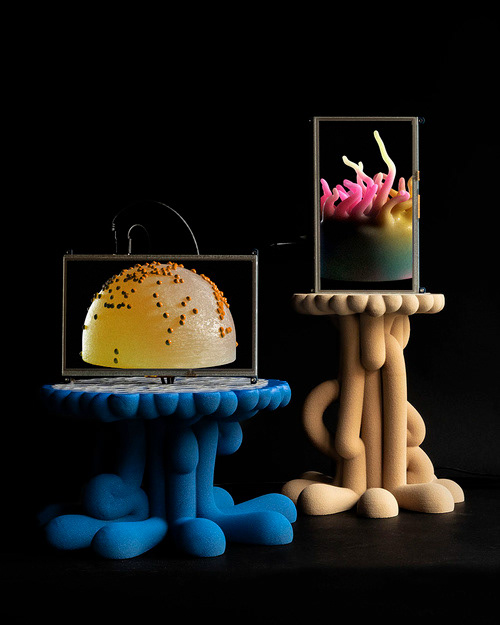
https://wangsoderstrom.com/digital-indulgence
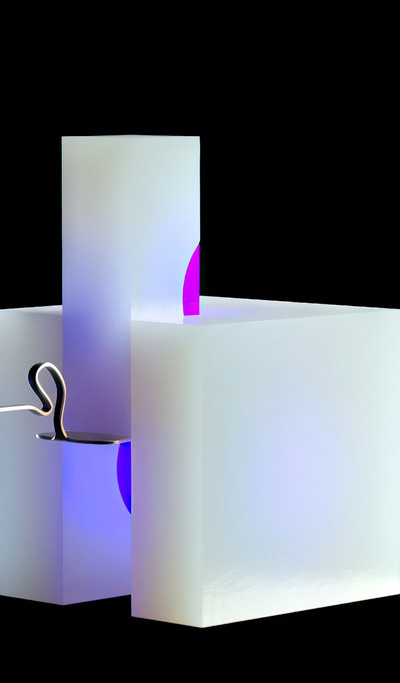
https://wangsoderstrom.com/digital-indulgence
Print city
I contacted Gary Buller at Print City to have the pieces printed. He has given his permission for the transcripts to be shared.
I sent Gary an email that included the .stl files for each object as well as a PreForm File with a proposed layout on the FormLabs 3L Printer. I initially wanted three Control Objects, but after I sent the email, I decided that I only needed one, due to the 140 and 249 frames clearly showing the control object within the negative space. Here are screenshots of my proposed layout.
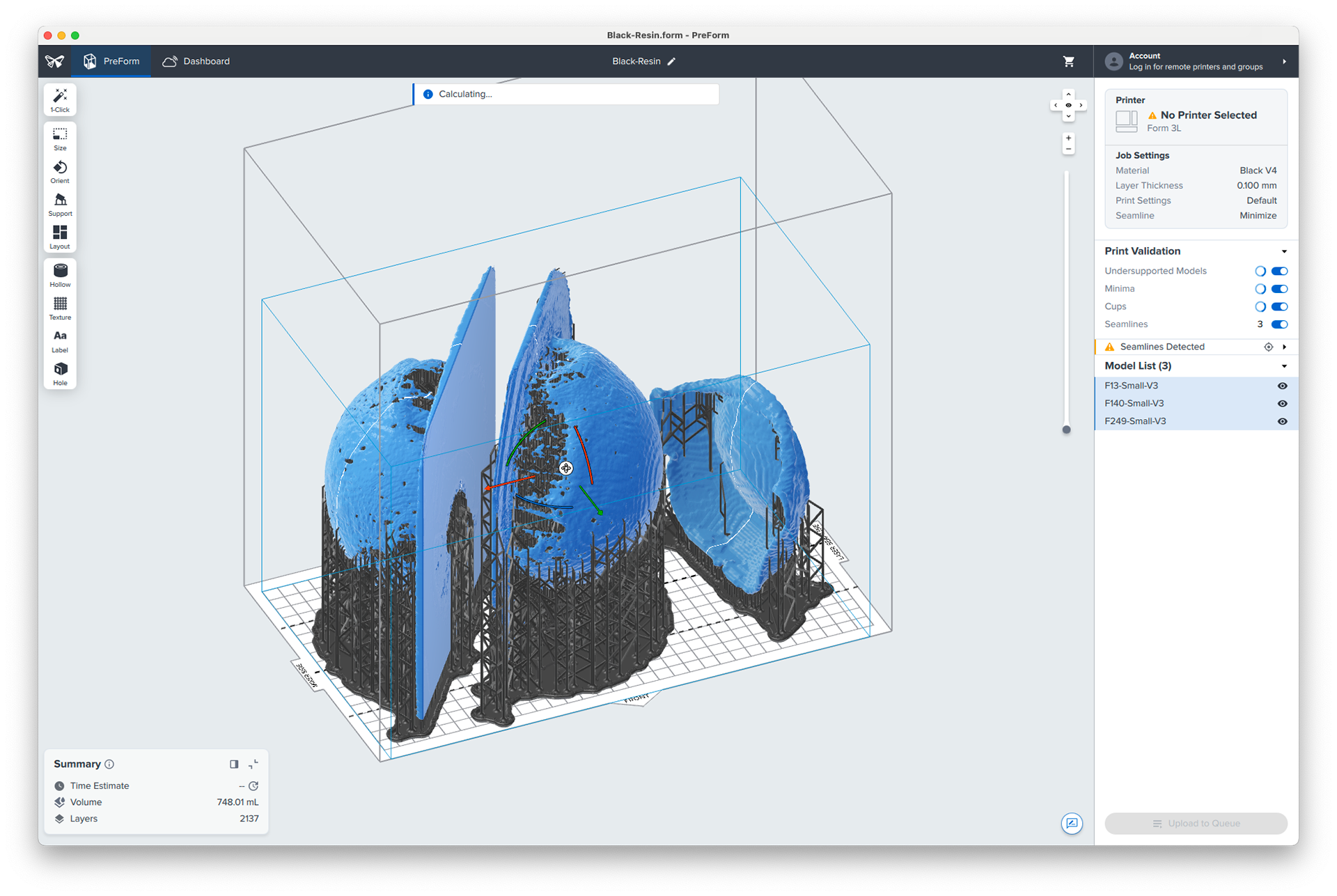
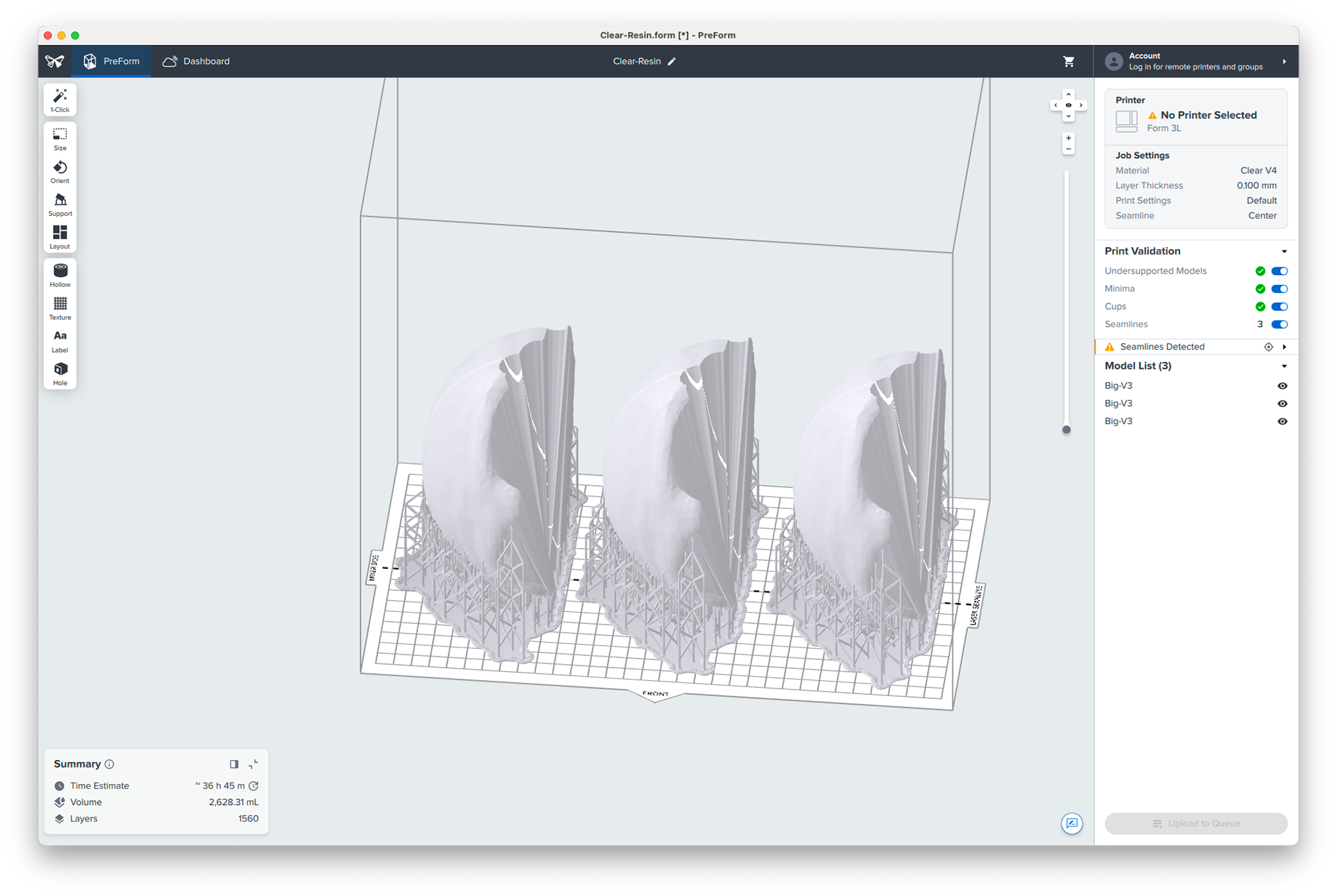
This was Gary's response.
I received the email just as I was leaving home and decided to reroute via Print City. Once I got there, we discussed why the cost was so high and what we could do to make it financially sensible without affecting the result too much. He showed me the print bed for the Form 4, and it was the perfect size, so I asked him if he could scale them down to fit and arrange them to minimise failure. A couple of hours later, I received this email.
I opened Preform and scaled my objects down by 0.6x, and they were indeed an appropriate measurement, so I proceeded.
Two working days later, they were ready to collect. Once I received the email for collection, I sent a follow-up email for the V4 files, requesting that they too were scaled down by 0.6x and reversing the colour scheme so that the 'control' is black and the 'personal' are clear.
I agreed to proceed and they were ready to collect the following day.
The total cost to make both sets was: £98.85. This is not equivalent to the real-world manufacture cost. Print City is non-profit, so I essentially paid for the resin cost and electricity usage. To gain an understanding of the ‘real-world' cost of making these parts, I uploaded V3 files to xometry.uk to get an instant quote. I couldn't figure out how to export an .stl from the PreForm file, so the quote is for the full-scale .stl files.
£1,379.07 was the cost for four objects. £844.22 was the price for a single 'Big-V3’, whereas Print City quoted me £400 for three. The other three objects’ total was £534.85 compared to Print City’s £120. A staggering difference. On average, the cost is a 500% increase for these objects compared to Print City. If the price:scale is linear (unlikely), it would be £827.44 compared to Print City’s £55.30. Since this is an instant online quote, it is unlikely that these figures would be the true cost, especially if I discussed an appropriate solution like I did with Gary. However, this does still give a rough cost. I did also contact FormLabs themselves to see if SLA Printing is a service they offer for black/clear resin, but I have not heard back.
Synthesis & Resolution Proposal
Throughout Unit X, I conducted research and developed a body of work centred around the concept of Duration. Drawing from the philosophical ideas of Bergson and exploring more recent primary research-based definitions of duration, I formulated my own unique “True Duration” definition. This definition was the catalyst for the project’s transition into the virtual realm, resulting in the decision to use software and machines to interpret real-world objects. This is the path I propose for Synthesis & Resolution.
All of my most captivating pieces have emerged from “Happy Accidents.” These include the destruction of V2, which inadvertently created an eye-catching piece, the cracking of plaster on V3 and V4, and the result of Fusion 360 “Close Holes” feature, which took the simplest yet most intelligent approach to closing the mesh form. These “Happy Accidents” have resulted in intriguing and popular outcomes.
In Synthesis & Resolution, I want to encourage these “Happy Accidents” within the virtual world by combining the two aspects I really enjoyed within this module, accidents and the virtual world. I also want to move out of resin and plastic material within 3D Printing and look at other options available to me. I want to go back to scanning and look at the full range of options, not just iPhone. To put this intent into a single sentence: How machines, hardware, and/or software view objects. Then following on from that, how can we harness that perspective and bring it back into the real world?